Media | Articles
The Ups and Downs of the Europa’s Nose
Last week I wrote about finishing the rear suspension work on the Armada by installing taller, stiffer Moog springs to go with the Bilstein shocks as part of the delete of the pneumatic self-leveling rear end. Today I’m going to address the yang to go with the Armada’s yin—lowering the front suspension of my 1974 Lotus Europa Twin Cam Special.
“Wait,” many of you are probably saying. “Haven’t you written about this before?” Yes. Multiple times. When I bought the long-dead car in 2013, it was sitting on the original springs and blown Armstong shocks. When I finally finished rebuilding the engine, woke the car from its nearly 40-year slumber, and got it running in 2019, I replaced the calipers, rotors, pads, ball joints, tie rods, and trunions, and drove it that way for a few months, but this wasn’t like reviving a Ford Model A milk truck that you only want to limp to Cars and Coffee twice a year—you want it to handle like a Lotus. The Armstrong shocks went out of production decades ago, so you need to choose between a few brands of shocks with adjustable firmness, height, or both. Plus, as I wrote about here, U.S.-spec Europa Twin Cams like mine had the nose artificially raised to satisfy Federal headlight spec requirements, and thus look a bit like a skiff on plane. Because of that, anyone like me going through a suspension refresh lowers the nose as part of it.


If you’ve learned anything from reading these pieces, it’s that I’m not a wealthy man, and in order to own, maintain, and drive 13 older vehicles, I am relentless about cost-containment and save money wherever I can. Replacing the entire suspension—shocks, springs, wishbones, everything—with new adjustable parts would’ve set me back $2500, and it seemed like massive overkill on a ratty, heavily-patina’d Europa. Staying focused on just the front shocks and springs, a set of new Spax height and firmness-adjustable shocks and matching lowering springs would’ve been about $800. Instead, for $225 I bought a set of four (front and rear) used Spax shocks on eBay that were what would’ve been put on the car in the early ’80s (firmness-adjustable but not height-adjustable), and bought a set of QA1 front lowering springs that had the height and spring rate widely recommended on Europa forums on Amazon for $80 for the pair. I eventually also bought the recommended lowering springs for the rear of the car. The lowered car, especially the nose, looked great—the car looked like it was ready to jump in at Le Mans (which, not coincidentally, was essentially the design goal of the Europa when it was first introduced—a mid-engined fiberglass-body-on-stressed-member-frame car for the masses).

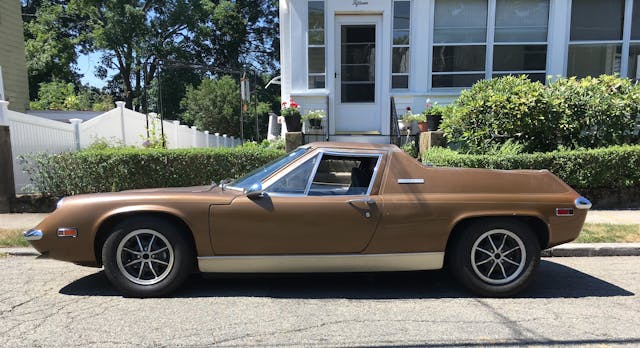
I found that lowering the car caused all four wheels to camber outward at the bottom, so I slotted the front wishbones and home-built adjustable links for the rear to compensate.

After dialing in toe and camber, the car handled well, but regardless of how I adjusted the stiffness of the front shocks, the front end always felt like it was about to break off if I hit any pavement irregularity bigger than a flattened soda can.
Marketplace
Buy and sell classics with confidence
So this spring, I took a step backward and undid everything. Well, not everything—the blown Armstrong shocks had long ago been thrown in the recycle bin—but I yanked out all four shocks and springs, removed the front and rear lowering springs, mounted the original springs on the 40-year-old adjustable Spax shocks, and undid my adjustable camber mods. Many reader’s comments to the piece linked to above were of the form “Kudos, to you, the designers usually knew what they were doing,” but this wasn’t a philosophical exercise in “stock is always better.” The banging indicated that something was wrong, and it stood to reason that something was done by me, so I wanted to undo it.
I reported that the car’s tolerance for pavement irregularity was much improved, but that turned out to be premature—when I drove it more, I discovered that when it encountered a pothole, frost heave, or step-change in road paving, there was still a clunk so severe that I wondered if the weld attaching the “hammerhead” section of the Europa’s T-on-Y-shaped frame was cracked.
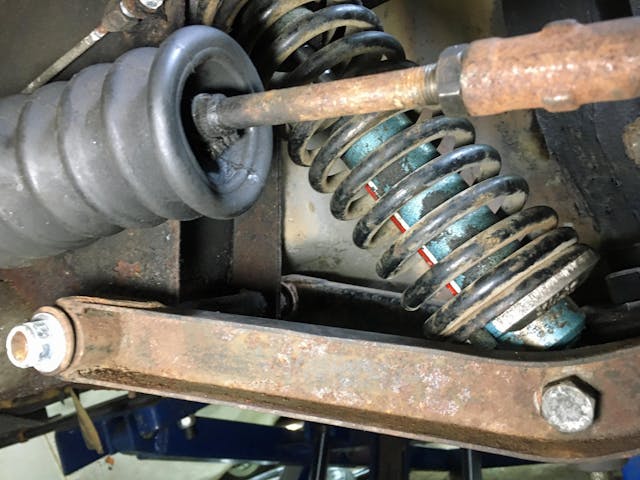

So early this summer I put the Lotus back up on the mid-rise lift and methodically dissected the front end. I roped my two adult children who live with us into bouncing the car while I laid beneath it, laying my hands and a mechanic’s stethoscope on every component. It made a small repetitive noise when bounced—not the obvious thunk/clunk like what I heard while driving, but something that shouldn’t be there. Visually I could see that it wasn’t due to coil-binding, and it didn’t seem to be the springs banging in the perches, but was very difficult to isolate. At first I swore it was coming from the wheel bearings. I tightened them, but no change. Then I discovered play in a long wishbone-securing bolt that went through a tubular sleeve. It shouldn’t have made a difference when the bolt was tightened, but I shimmed it with a cut-up seltzer can anyway. No change. It was maddening.
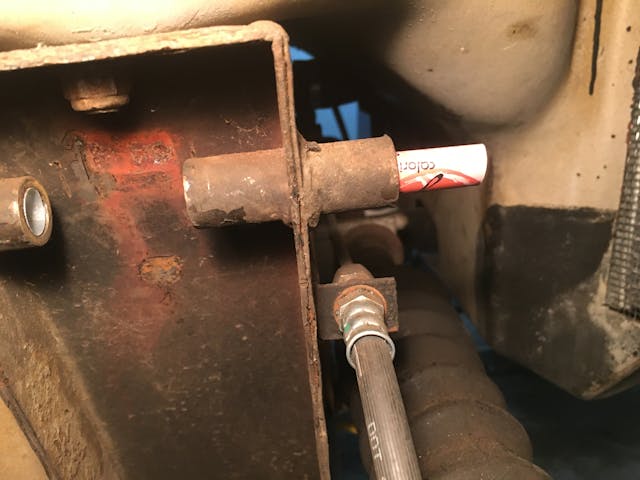
Frustrated, I entered into a scheme of systematically removing front-end components. The sway bar came off first. Then I supported the ends of the lower wishbones on jack stands and removed the wheels, rotors, and bearings, thereby letting me bounce the car on the suspension while taking these components out of the picture. I went a step further by removing the trunions. Next I eliminated the steering as a cause by undoing the tie rods and removing the steering knuckles. It turned out that there was a bit of play in both the steering column and the rack, but the primary noise was still there.

Eventually, all that was left were the shocks, springs, and wishbones. The wishbones and their rubber bushings were original to the car, so they were certainly not beyond suspicion. I’d left them in place five years ago because the bushings were hard but not degraded and wouldn’t succumb to being pressed out without risking bending the feather-light no-longer-available wishbones. I found that the noise manifested itself at the top of the load on the shocks—that is, if I bounced the car a few times to create the noise, it occurred at a certain suspension height, but if then lifted up the nose and allowed the shocks to extend, the noise occurred higher up. This seemed to clear the wishbones and implicate the shocks as the source of the noise.
I was willing to pay the $600 cost for a new set of Spax fully-adjustable shocks, but I needed to be virtually certain they’d fix the problem, because if they didn’t, I was going to be pissed. I found that if I ordered them from a Lotus house in England I could save about $70, but the main supplier of vintage Lotus parts on the east coast is RD Enterprises in Pennsylvania, they’re an essential part of the vintage Lotus community, and I do enough price-shopping and click-and-buying of normal-wear-and-tear parts (certain items are shared with Triumphs) from other vendors that I felt it was important to give RD this sale.
While waiting on shipment, I pulled the suspect Spax shocks with the original springs on them out of the car. I thought about pulling the springs off them so I could directly extend and compress the shocks and feel if they were bad, but I decided against it, as it would just make work for myself, and didn’t replicate what actually happens under load.
A few days later, the box containing the brand-new school bus-yellow firmness-and-height-adjustable Spax shocks arrived. I broke out my Rube Goldberg homemade spring compressor one more time and mounted the QA1 lowering springs on the shocks, which was way easier than mounting the original springs was because the shorter springs require much less compression. I reassembled the front end, which I’ve gotten very good at because this was the third time I’ve done it.
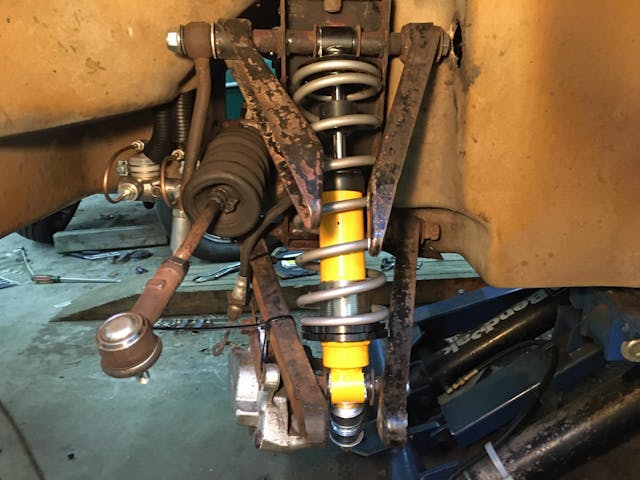
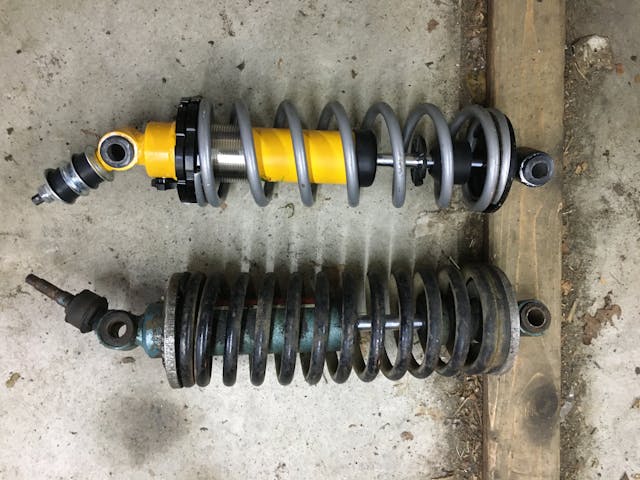
And then life in all its glorious automotive and non-automotive forms interfered. The Lotus sat on my mid-rise lift all summer while I futzed with the Armada’s flaky air conditioning, visited my middle son in Santa Fe, and bought, regretted, and embraced the FrankenThirty. I didn’t really mind. Most of my vintage cars have air conditioning, but the Lotus is not among them, and there’s a slightly acidic mousy tang to the car’s scent that doesn’t play well with summer weather (hot, humid, and mousy is rarely a good combination), so waiting ‘till the crisp breath of September to drive it was fine. It actually was the need to swap wheels and tires on the FrankenThirty that got the Lotus kicked off the lift, out of the garage, and into the driveway, and my realizing that I hadn’t driven it since the new shocks went in was almost an afterthought.
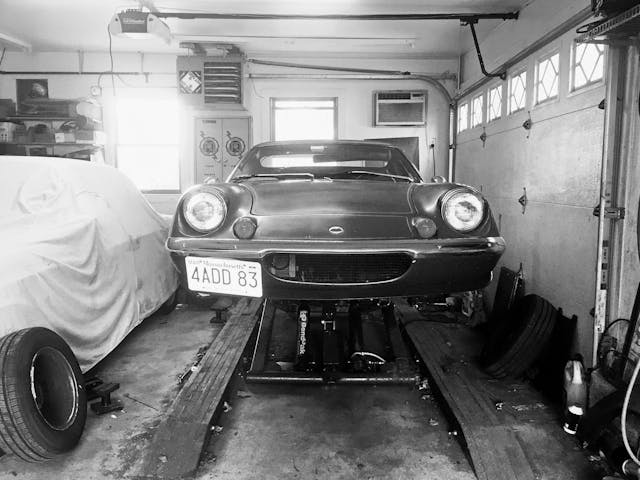
Okay then. Around the block it went. There were a few groans as things settled, but nothing egregious. I then headed for “the torture track”—a particularly badly-paved stretch of road a few streets over. Thunk-and-clunk-wise, things seemed much better, but the steering seemed to get looser by the minute, and the handling felt odd. I put the car back in the garage and found that I hadn’t sufficiently tightened down a collar nut after adjusting the steering column, and had forgotten to slide the upper ball joint forward in the slotted holes I’d made in the wishbones to account for the camber change from lowering the car.
I made those changes, went around the block again, then drove the car about 20 miles on the twisty roads in the affluent leafy suburbs west of Boston where driving the Europa at 42 mph in a 35 zone is so much fun that you feel like you should be arrested.
And?
Oh my lord. I nailed it. The front-end banging is completely gone. I don’t need to cringe and tighten my abs and sphincter every time I approach uneven terrain and slow to a crawl over railroad tracks. It feels absolutely amazing. In retrospect, yeah, I should’ve just paid the money and done this five years ago. Whether the eBay Spax shocks are actively broken, or somehow mismatched to the springs, or were for a Europa S2 but not a Twin Cam, I don’t know. And I don’t care.
There’s still tweaking to be done—I haven’t realigned it, and the 75-mph highway stability of the car isn’t quite what I’d like. Plus, the rear of the car is still sitting on the 40-year-old Spax shocks and original springs. But the novelty of the car no longer feeling like someone dropped an apple crate full of tools over every bump is going to take a long time to wear off.
And yes, the car now looks level, and that nose looks properly settled, with Lolita showing just a hint of ankle. She is, after all, a lady.

***
Rob’s latest book, The Best Of The Hack Mechanic™: 35 years of hacks, kluges, and assorted automotive mayhem, is available on Amazon here. His other seven books are available here on Amazon, or you can order personally inscribed copies from Rob’s website, www.robsiegel.com.

















Knowing what I know about aging seals and rubber, I’m sure the 40 year old shocks were doing a fantastic job of existing and not much else.
Glad to see it’s riding much better with the new dampers!
Rob, congrats on reaching the best combination of parts and assembling to date. It is indeed great when you climb into a car and get to drive it the way it’s intended to be driven – and without excessive worrying.
Rob, great to hear after summer of resting on your only lift the Lotus is now out and about, and just in time for salt and ice season. Now you can recover your $225 dollars by selling the 40 year old out of production shocks to the next desperate soul. Happy Motoring and your Lotus does look better level then in position to rotate into flight.
That is some great detective work, well done Sir.
I think we all appreciate the pragmatic, practical diagnostic process Rob applies to unique conditions. Without a doubt, Rob is an unrivaled, intrepid diagnostician par excellence (sorry; I was taught to espouse elucidation and eschew obfuscation).
The problem with eschewing obfuscation is that it’s so difficult to swallow that one must spit it out.
Love the zip tied caliper on the lower wishbone in the last assembly photo. After dozens of calipers falling from hopeful perches or hooks that seem to de-hook as soon as my back is turned, I have gone full zip tie too!
Having had much experience with Europas (including a sable brown one I bought new), I loved the story. Don’t ask about having to pull the engine twice in my Plus 2 to finally find out that the new reproduction 2nd gear synchro I bought was preventing the car from shifting into 2nd gear.
If you follow the contour from the headlamp area through the door’s belt molding, that and the shape of the upper window frame exacerbate the Europa’s nose-up look.
Great to see the car is now riding without you getting tense at all the bumps. Moving forward!
Remember the old blasting cap posters, the ones they used to show us in elementary school? I think the Lotus deserves one. DANGER! (insert picture of Lotus) If you see one of these DON’T TOUCH IT! Leave it alone, and report the sighting to someone with more sense
Blasting caps at your elementary school? That’s a bigger mystery than the clunky shocks! Was there a coal mine under your school? In concept, I have to agree, English car design makes as much sense as knickers and spats.
Did you consider swapping out the Type 65 springs for a set of used Type 54 springs?
Bob, no, I didn’t consider that. The S1/S2 workshop manual lists the free length as 12.75 inches, 17 coils, wire diameter .348 inches. The Twin Cam’s front springs are listed as having a free length of 12.51 inches, 13.5 coils, and a .40 inch wire diameter. I read dozens of posts on multiple forums about lowering the nose, including, if memory serves me correctly, swapping the lower and upper control arms (or was it left to right; I forget). The only posts I read where there were multiple people who said “I did it and it solved the problem” was height-adjustable shocks with lowering springs. I went with the Spax shocks because there was the largest number of posts from people who had used them. I went with the 10-inch 125-pound springs because that’s what RD Enterprises sells in their kit. There were many posts of people who track their car using shorter and stiffer springs.
I feel for your comment about getting very good at replacing the front end after doing it 3 times. I had the transaxle/torque tube out of my 63 Lemans convertible 8 different times before finally getting the correct 4 speed in and working properly.
Rob, 40 year old shocks? Really… how long have you been working on old cars? Long enough to know better, I’d think!! You should have replaced those upper arm bushings also. They might work good for now, but those old things will go next. It’s something you will have to take the front end apart to replace YET AGAIN, but then you’re good at that by now.
Old parts with seals are bad news, you should know this by now!! They dry rot, or dry out and fail shortly after putting into service. At least you don’t pay much for them… but I am a bit surprised you even gave them a try!
When I first purchased the used Spax shocks (and their 40 year age is a guess from the color), I first verified with the eBay seller that I could test them by manually extending and compressing them to make sure they were neither seized nor blown and adjust the firmness settings to see if they responded. I did, and they did, so I kept them. I’m still not certain why they and two different sets of springs didn’t behave in the car.
Regarding the wishbone bushings, as I said, the wishbones are very light and fragile and are no longer made. I have a decent press, and used it to try to press the old bushings out, and was at the point where the wishbones began to bend. I have a chapter in my first book about how you when you go into a cave with a beast in it, you need to be prepared to either battle the beast to the death or know when to back out of the cave. With the bushings and the wishbones, I backed out of the cave.
Yup, we had blasting cap posters in elementary school too. Even had a guy come to class with a lecture and display. It made us ache to find one but alas, never did.
yep, me too!
i grew up in western PA coal country.
You always take great pictures that help illustrate your stories.
Car sits great now. Big difference. Have fun with it now that it is cooler out.